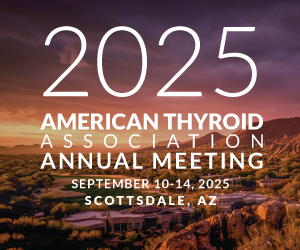
Parathyroid Glands – Why and how we should preserve them during neck surgery
Carolyn Dacey Seib, MD, MAS
Stanford University School of Medicine
Stanford, CA
April 19, 2022
The parathyroids are small, oval-shaped glands that tightly regulate serum calcium levels through the production of parathyroid hormone (PTH), which stimulates the release of calcium from bone, increased GI absorption of calcium, and decreased renal excretion of calcium. Most commonly, each person has four parathyroid glands that are located in the neck, with two on each side, behind and just below each lobe of the thyroid gland.
Given their proximity to the thyroid and critical role in maintaining calcium homeostasis, it is important for surgeons to identify and protect the parathyroid glands during thyroid surgery. They can be as small as a grain of rice and encased in fat, making them difficult to identify. In addition, each parathyroid gland has a delicate blood supply and may be adherent to the capsule of the thyroid. Therefore, fine dissection is needed to preserve them in situ and with intact blood flow. If all parathyroid glands are injured, devascularized, or inadvertently removed during total or completion thyroidectomy, patients may experience temporary or permanent hypoparathyroidism, which is decreased production of PTH that results in hypocalcemia. Symptoms of hypocalcemia due to hypoparathyroidism include numbness and tingling in the fingers and around the mouth, muscle cramps or, when more severe, laryngospasm, seizures and dysrhythmias due to QT prolongation. The mainstay of treatment for hypoparathyroidism is supplementation with calcium and active vitamin D, which can be cumbersome for patients if large or frequent doses are required to prevent symptoms.
Permanent hypoparathyroidism is associated with impaired quality of life and long-term renal complications.(1,2) Although historically thought to be rare, recent studies suggest this complication may occur in up to 5% to 15% of patients following thyroidectomy.(3,4) As a result, there has been a renewed focus on techniques to identify and preserve parathyroid glands during operations in the neck. The most promising methods include near-infrared autofluorescence (NIRAF), which comes in probe-based and image-based systems, and parathyroid angiography using the fluorescent dye indocyanine green (ICG). NIRAF relies on the fact that parathyroids exhibit fluorescence, meaning when illuminated with light of a specific wavelength they reflect light back with a different wavelength. This allows the parathyroid glands to be differentiated from surrounding thyroid, fat, or lymph nodes and more easily identified.(5) In randomized clinical trials, NIRAF has been shown to improve the identification of parathyroid glands during thyroid surgery and decrease the rates of parathyroid autotransplantation, inadvertent parathyroid removal, and postoperative hypocalcemia.(6,7) However, autofluorescence is an intrinsic property of parathyroid tissue, detectable when the gland is in or out of the body, and does not predict viability. Parathyroid angiography with ICG can assess parathyroid gland perfusion at the conclusion of thyroidectomy to make decisions about parathyroid autotransplantation and guide postoperative calcium supplementation.(8,9) Given the documented short-term benefits of these tools are promising, additional studies are underway to determine long-term outcomes with their use. In addition to meticulous surgical technique, fluorescence imaging systems hold promise as adjunct tools to identify and preserve functional parathyroid glands during thyroid operations and reduce the risk of postoperative hypoparathyroidism.
References:
1. Büttner M, Musholt TJ, Singer S. Quality of life in patients with hypoparathyroidism receiving standard treatment: a systematic review. Endocrine. 2017;58(1):14-20.
2. Mitchell DM, Regan S, Cooley MR, et al. Long-Term Follow-Up of Patients with Hypoparathyroidism. The Journal of Clinical Endocrinology & Metabolism. 2012;97(12):4507-4514.
3. Maurer E, Maschuw K, Reuss A, et al. Total versus near-total thyroidectomy in Graves disease: results of the randomized controlled multicenter TONIG-trial. Annals of surgery. 2019;270(5):755-761.
4. Lončar I, Noltes ME, Dickhoff C, et al. Persistent Postthyroidectomy Hypoparathyroidism in the Netherlands. JAMA Otolaryngology–Head & Neck Surgery. 2021.
5. Solórzano CC, Thomas G, Berber E, et al. Current state of intraoperative use of near infrared fluorescence for parathyroid identification and preservation. Surgery. 2021;169(4):868-878.
6. Benmiloud F, Godiris-Petit G, Gras R, et al. Association of Autofluorescence-Based Detection of the Parathyroid Glands During Total Thyroidectomy With Postoperative Hypocalcemia Risk: Results of the PARAFLUO Multicenter Randomized Clinical Trial. JAMA Surgery. 2020;155(2):106-112.
7. Dip F, Falco J, Verna S, et al. Randomized Controlled Trial Comparing White Light with Near-Infrared Autofluorescence for Parathyroid Gland Identification During Total Thyroidectomy. Journal of the American College of Surgeons. 2019;228(5):744-751.
8. Vidal Fortuny J, Belfontali V, Sadowski S, Karenovics W, Guigard S, Triponez F. Parathyroid gland angiography with indocyanine green fluorescence to predict parathyroid function after thyroid surgery. Journal of British Surgery. 2016;103(5):537-543.
9. Vidal Fortuny J, Sadowski S, Belfontali V, et al. Randomized clinical trial of intraoperative parathyroid gland angiography with indocyanine green fluorescence predicting parathyroid function after thyroid surgery. Journal of British Surgery. 2018;105(4):350-357.
Disclaimer:
The ideas and opinions expressed on the ATA Blogs do not necessarily reflect those of the ATA. None of the information posted is intended as medical, legal, or business advice, or advice about reimbursement for health care services. The mention of any product, service, company, therapy or physician practice does not constitute an endorsement of any kind by ATA. ATA assumes no responsibility for any injury or damage to persons or property arising out of or related to any use of the material contained in, posted on, or linked to this site, or any errors or omissions.
For more information on Thyroid Topics please visit: https://www.thyroid.org/thyroid-information/
We invite you to submit any questions or comments regarding this blog post below, for potential response in a future blog or social media post.



